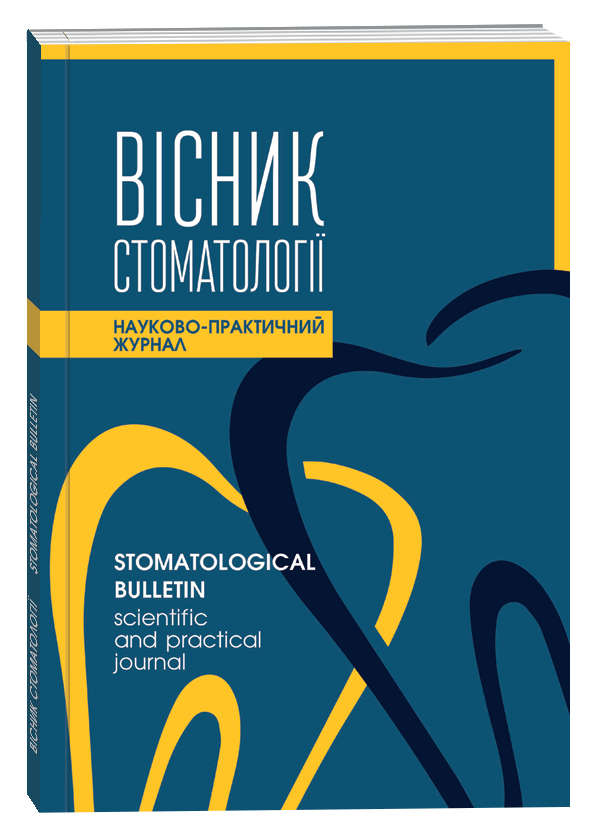CLINICAL EFFICACY OF SURGICAL TREATMENT OF MANDIBULAR HEAD FRACTURES USING NAVIGATION TEMPLATES AND PATIENT-SPECIFIC IMPLANTS
DOI:
https://doi.org/10.35220/2078-8916-2020-37-3-41-49Keywords:
surgical treatment, fracture of the head of the lower jaw, rehabilitation of patientsAbstract
Introduction. Fractures of the condyle process of the lower jaw are one of the most common types of its trau-matic lesions. According to the literature, 25-40 % of fractures of the lower jaw are localized in the condyle process. Among them, 25-30 % are the most difficult to diagnose and treat fractures of the head of the lower jaw.
The aim of this study was to evaluate the clinical and functional efficacy of navigation templates and patient-specific retainers in patients with a mandibular head fracture compared to traditional methods of osteosynthesis.
The material of this study was 37 patients with 48 frac-tures of the head of the lower jaw (31 men and 6 women, aged 19 to 61 years, mean age 38 ± 11.8 years). Depend-ing on the method of osteosynthesis of the lower jaw head, all patients were divided into 2 groups, uniform in age, gender and severity of injury.
Patients in both groups were examined according to a standard scheme that included Anamnesis collection, as-sessment of general and local status, and the use of la-boratory and instrumental research methods.
The use of navigation surgical templates and patient-specific retainers in patients with a fracture of the head of the lower jaw can improve the anatomical and functional results of their surgical treatment, namely, to increase the accuracy of restoring the anatomical shape of the head, reduce the frequency of occlusive disorders and second-ary displacements, as well as increase the maximum range of movements of the lower jaw by 6.4-20 %.
References
He D, Yang C, Chen M, Jiang B, Wang B. Intracapsular condylar fracture of the mandible: our classifica-tion and open treatment experience. J Oral Maxillofac Surg. 2009;67(8):1672-1679. doi:10.1016/j.joms.2009.02.012 2. Umstadt HE, Ellers M, Müller HH, Austermann KH. Functional reconstruction of the TM joint in cases of se-verely displaced fractures and fracture dislocation. J Craniomaxillofac Surg. 2000;28(2):97-105. doi:10.1054/jcms.2000.0123
Dahlstrom L, Kahnberg KE, Lindahl L. 15 years follow-up on condylar fractures. International journal of oral and maxillofacial surgery 1989;18:18-23
Liu Y, Bai N, Song G, Zhang X, Hu J, Zhu S, Luo E. Open versus closed treatment of unilateral moderately dis-placed mandibular condylar fractures: a meta-analysis of ran-domized controlled trials. Oral Surg Oral Med Oral Pathol Oral Radiol. 2013; 116: 169-73.
Rasse M. NeuereEntwicklungen der Therapie der Gelenkfortsatzbruche¨ der Mandibula (Recent developments in therapy of condylar fractures of the mandible). Mund Kiefer Gesichtschir. 2000;4:69–87
Kolk A, Neff A. Long-term results of ORIF of condy-lar head fractures of the mandible: A prospective 5-year follow-up study of small-fragment positional-screw osteosynthesis (SFPSO). J Craniomaxillofac Surg. 2015; 43(4):452-461.
Coletti DP, Salama A, Caccamese JF. Application of intermaxillary fixation screws in maxillofacial trauma. Journal of oral and maxillofacial surgery : official journal of the Ameri-can Association of Oral and Maxillofacial Surgeons. 2007;65: 1746-50.
Neff A, Kolk A, Neff F, Horch HH Surgical vs. con-servative therapy of diacapitular and high condylar fractures with dislocation. A comparison between MRI and axiography. Mund Kiefer Gesichtschir. 2002;6:66-73.
Eckelt U, Schneider M, Erasmus F, Gerlach KL, Kuhlisch E, et al. Open versus closed treatment of fractures of the mandibular condylar process-a prospective randomized mul-ti-centre study. J Craniomaxillofac Surg. 2006; 34:306-14.
Hlawitschka M., Loukota R., Eckelt U. Functional and radiological results of open and closed treatment of intracapsular (diacapitular) condylar fractures of the mandible. Int. J. Oral Maxillofac. Surg. 2005;34:597–604. 11. Chrcanovic B.R. Open versus closed reduction: diacapitular fractures of the mandibular condyle. Oral Maxillofac Surg. 2012;16(3):257-265. doi:10.1007/s10006-012-0337-6.
Neff A., Mühlberger G., Karoglan M., et al. Stabilität der Osteosynthese bei Gelenkwalzenfrakturen in Klinik und biomechanischer Simulation [Stability of osteosyntheses for condylar head fractures in the clinic and bio-
mechanical simulation] [published correction appears in Mund Kiefer Gesichtschir. 2004 Jul;8(4):264]. Mund Kiefer Gesichtschir. 2004;8(2):63-74.
McLeod N.M., Saeed N.R. Treatment of fractures of the mandibular condylar head with ultrasound-activated resorbable pins: early clinical experience. Br J Oral Maxillofac Surg. 2016;54(8):872-877.
Kozakiewicz M. Small-diameter compression screws completely embedded in bone for rigid internal fixation of the condylar head of the mandible. Br J Oral Maxillofac Surg. 2018Jan;56(1):74-76.
Neff A., Kolk A., Meschke F., Deppe H., Horch H.H. Kleinfragmentschrauben vs. Plattenosteosynthese bei Gelenkwalzenfrakturen. Vergleich funktioneller Ergebnisse mit MRT und Achsiographie [Small fragment screws vs. plate osteosynthesis in condylar head fractures]. Mund Kiefer Gesichtschir. 2005;9(2):80-88.
Pilling E, Schneider M, Mai R, Loukota RA, Eckelt U. Minimally invasive fracture treatment with cannulated lag screws in intracapsular fractures of the condyle. J Oral Maxillofac Surg. 2006;64(5):868-872. 17. Shakya S., Zhang X., Liu L. Key points in surgical management of mandibular condylar fractures. Chin J Traumatol. 2020;23(2):63-70. doi:10.1016/j.cjtee.2019.08.006.
Pavlychuk T., Chernogorskyi D., Cherupnyi Yu., Neff A., Kopchak A. Application of CAD/CAM technology for surgical treatment of condylar head fractures: A preliminary study. J Oral Biol Craniofac Res. 2020;10(4):608-614.
Axhausen G. Die operative Freilegung des Kiefergelenks. Chirurg. 1931; 3:713-719.
Bockenheimer P. Eine neue Methode zur Freilegung des Kiefergelenke ohne sitchbare Narben und ohne Veletzung des Nervus facialis. Zentalbl Chir. 1920; 47:1560-1579.
McNamara J.A. A method of cephalometric evalua-tion. Am J Orthod. 1984;86:449.
Helkimo M. Studies on function and dysfunction of the masticatory system. IV. Age and sex distribution of symp-toms of dysfunction of the masticatory system in Lapps in the north of Finland. Acta odontologica Scandinavica. 1974;32: 255-67.
Han C., Dilxat D., Zhang X., Li H., Chen J., Liu L. Does Intra-operative Navigation Improve the Anatomical Re-duction of Intracapsular Condylar Fractures? J Oral Maxillofac Surg. 2018 Dec;76(12):2583-2591. doi: 10.1016/j.joms.2018.07.030.
Karan A., Kedarnath N.S., Reddy G.S., Harish Kumar T.V., Neelima C., Bhavani M., Nayyar A.S. Condylar fractures: Surgical versus conservative management. Ann Maxillofac Surg. 2019;9:15-22 25. Wang H.D., Susarla S.M., Yang R., Mundinger G.S., Schultz B.D., Banda A., MacMillan A., Manson P.N., Nam A.J., Dorafshar A.H. Does Fracture Pattern Influence Functional Outcomes in the Management of Bilateral Mandibu-lar Condylar Injuries? Craniomaxillofac Trauma Reconstr. 2019 Sep;12(3):211-220. doi: 10.1055/s-0038-1668500. Epub 2018 Sep 21. PMID: 31428246; PMCID: PMC6697470.









